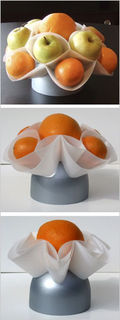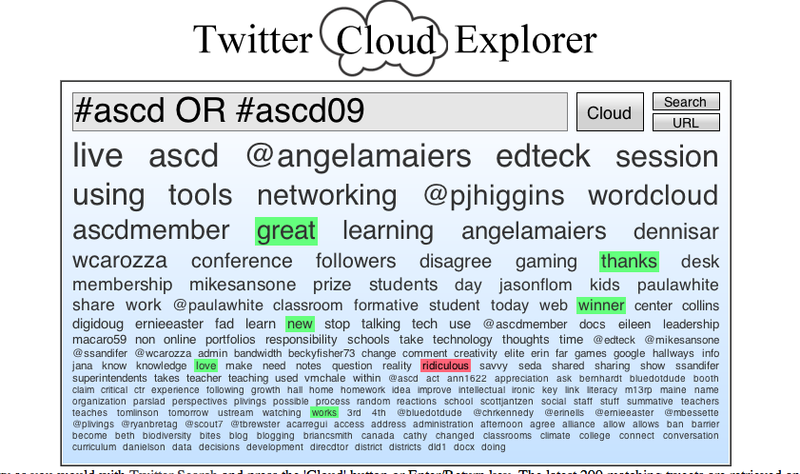Great to meet you… My name's Peter Pappas, from Rochester NY. I taught high school social studies for over 25 year, became a K-12 coordinator and then finished the last 5 years of my career as a assistant superintendent for instruction. Since then, I've been able to devote myself, full time, to expanding my role as a staff developer and consultant.
I've had the chance to work with districts across the country with a focus on literacy, technology, document-based instruction and student engagement. Staff development should model what we want to see in the classroom, so I bring an audience response system and we actually use the techniques I'm promoting!
Follow me on Twitter – hope you have a great conference!
Oh .. and … have you heard of any good sushi restaurants nearby? …..
Note: As of 4/26/09 the TwitterCloudExplorer seems to have disappeared. Here's a screen shot of what it looked like during the ASCD conference. Notice my Twitter name edteck was the 4th most Twittered word when I took the screen shot.
Technical Specs1. Hashtags are a community-driven convention for adding additional context and metadata to your tweets. They're like tags on Flickr, only added inline to your post. You create a hashtag simply by prefixing a word with a hash symbol: #hashtag. I sought out the relevant hashtags people are using for the ASCD conference. Note: It seems this year both #ASCD and #ASCD09 are being used. For more on hashtags2. I used a Twitter Search to look for people using the #ASCD OR #ASCD09 hashtags. Search results here.3. Then I sent out Tweets to people using either hashtag with a link back to this post. Hopefully their replies will follow.4. I'm a big fan of quantitative display of information, so I used one the many new Twitter visualization tools – Twitter Cloud Explorer to generate this embedded query. Note: As of 4/26/09 the TwitterCloudExplorer seems to have disappeared. There are many new Twitter visualizations coming along every day.
Middle School Students Video – No Future Left Behind
Wiimote Interactive IR Pen Whiteboard Solution
Physics Department Innovates with Student-Centered Approach
At M.I.T., two introductory courses are still required — classical mechanics and electromagnetism — but today they meet in high-tech classrooms, where about 80 students sit at 13 round tables equipped with networked computers.
Instead of blackboards, the walls are covered with white boards and huge display screens. Circulating with a team of teaching assistants, the professor makes brief presentations of general principles and engages the students as they work out related concepts in small groups.
Teachers and students conduct experiments together. The room buzzes. Conferring with tablemates, calling out questions and jumping up to write formulas on the white boards are all encouraged.
“There was a long tradition that what it meant to teach was to give a really well-prepared lecture,” said Peter Dourmashkin, a senior lecturer in physics at M.I.T. and a strong proponent of the new method. “It was the students’ job to figure it out.”
The problem, say Dr. Dourmashkin and others in the department, is that a lot of students had trouble doing that. The failure rate for those lecture courses, even those taught by the most mesmerizing teachers, was typically 10 percent to 12 percent. Now, it has dropped to 4 percent.
… The traditional 50-minute lecture was geared more toward physics majors, said Eric Mazur, a physicist at Harvard who is a pioneer of the new approach, and whose work has influenced the change at M.I.T.
“The people who wanted to understand,” Professor Mazur said, “had the discipline, the urge, to sit down afterwards and say, ‘Let me figure this out.’ ” But for the majority, he said, a different approach is needed.
“Just as you can’t become a marathon runner by watching marathons on TV,” Professor Mazur said, “likewise for science, you have to go through the thought processes of doing science and not just watch your instructor do it.”
Teaching Innovation
 Innovation – an idea put to work – stands at the pinnacle of higher-order thinking. It begins with a firm grasp of the basics. Then the innovator must continue up through Bloom's taxonomy of thinking skills to analyze patterns and needs, evaluate alternatives and finally create something to resolve to the problem. Creating is nothing more than a new combination of existing components.
Innovation – an idea put to work – stands at the pinnacle of higher-order thinking. It begins with a firm grasp of the basics. Then the innovator must continue up through Bloom's taxonomy of thinking skills to analyze patterns and needs, evaluate alternatives and finally create something to resolve to the problem. Creating is nothing more than a new combination of existing components.<<< The Elizabowl’s shape shifts to hold more or fewer fruits. The idea is to separate fruits into individual compartments to retard spoilage. Photo by by Sarah O'Brien (it's inventor)

